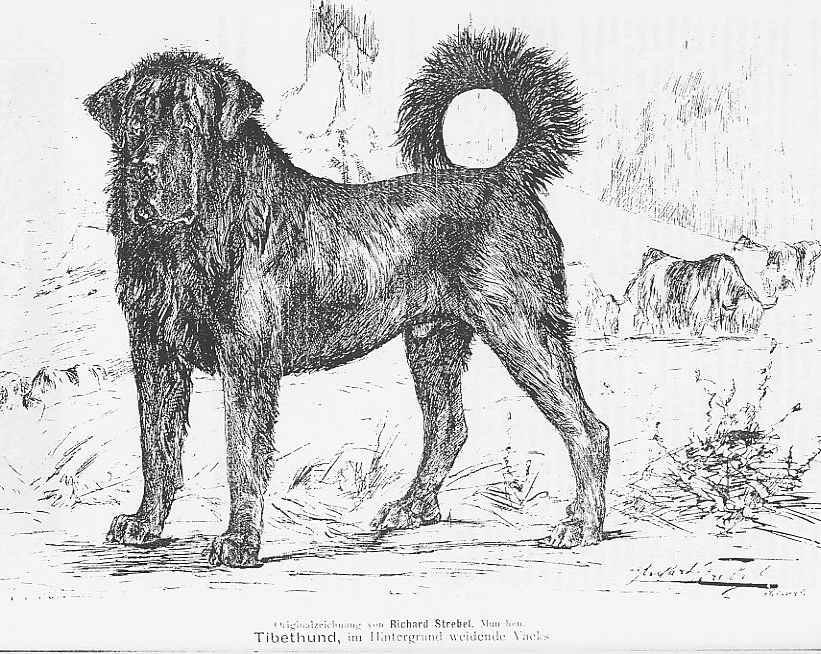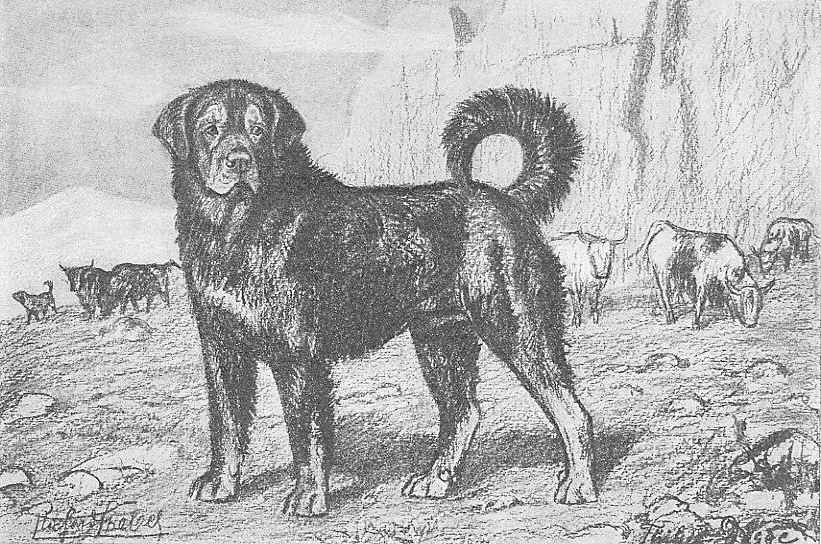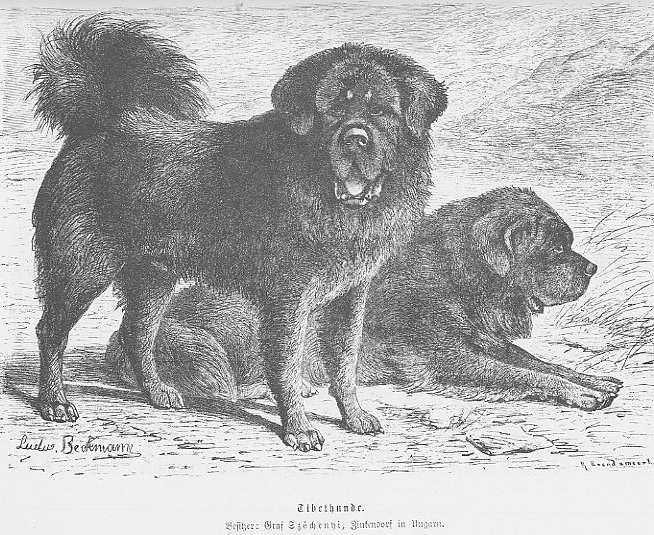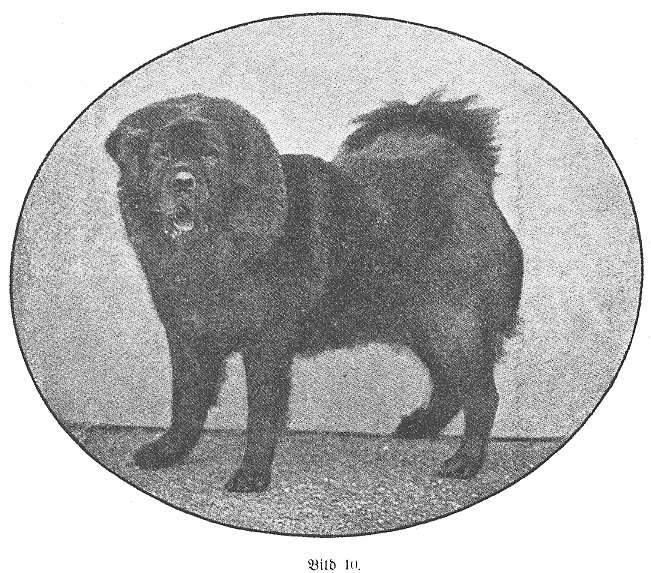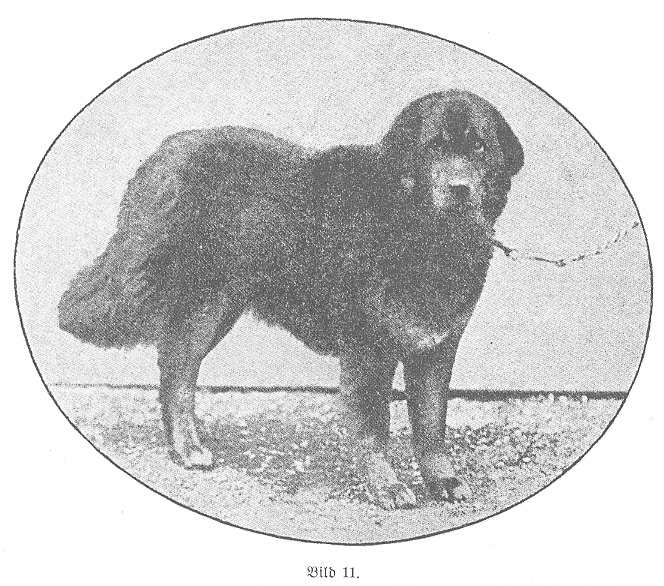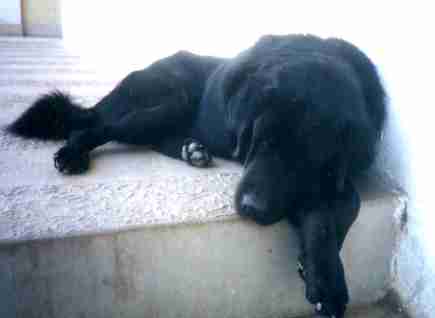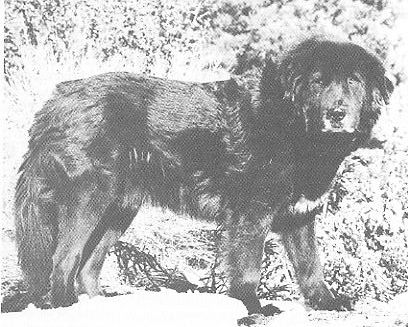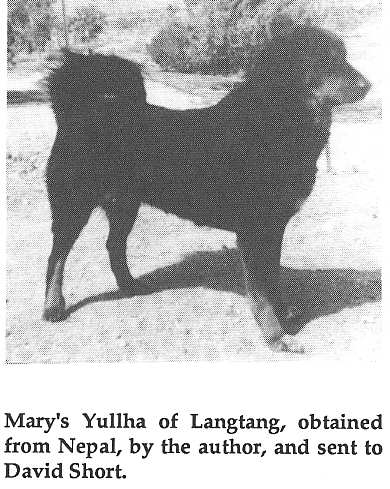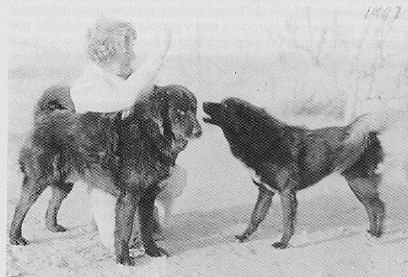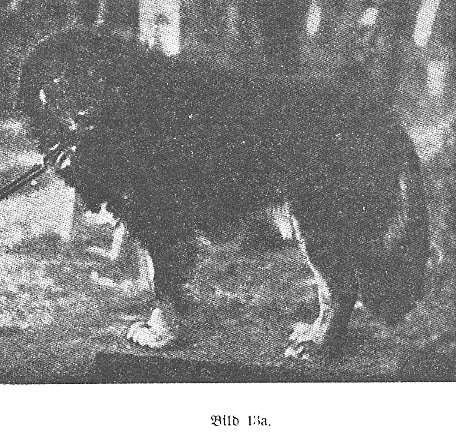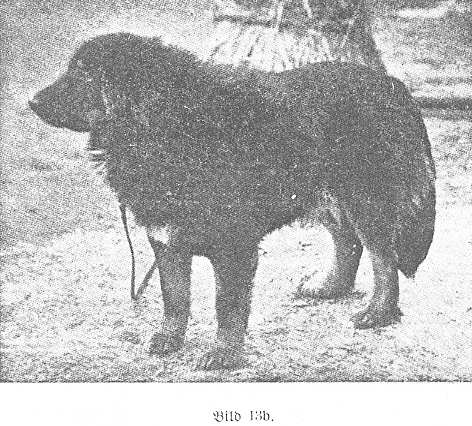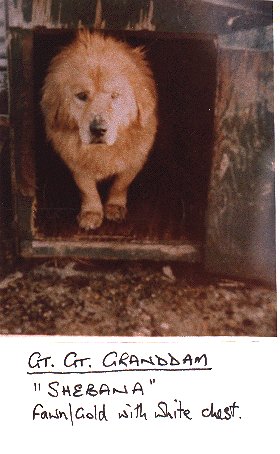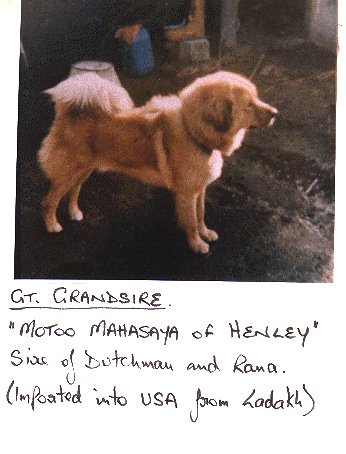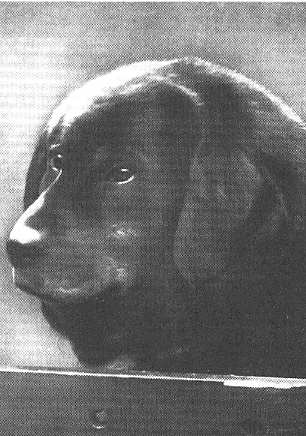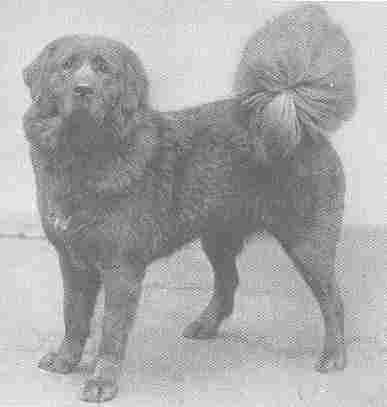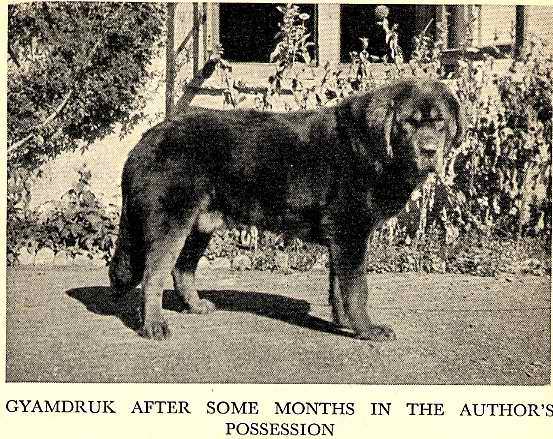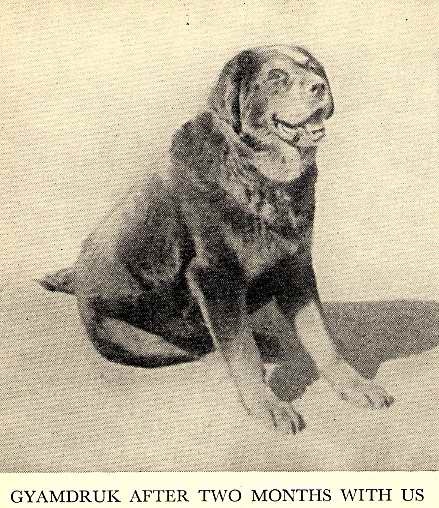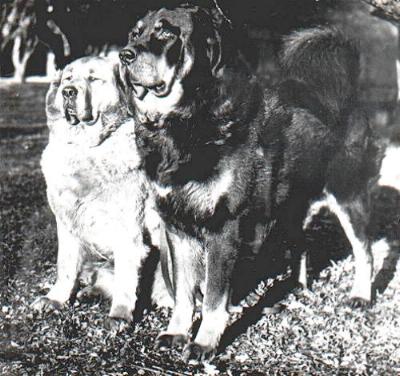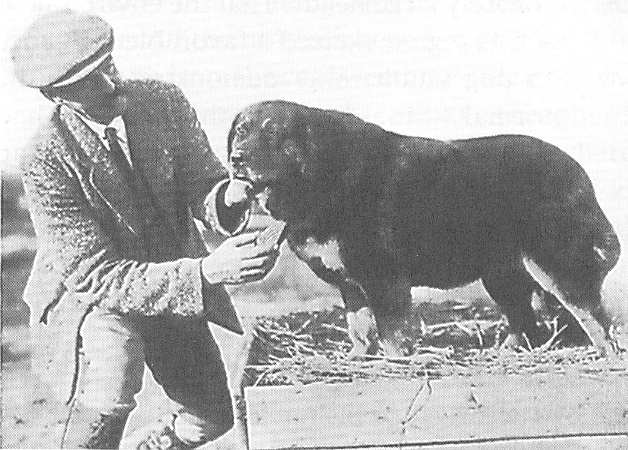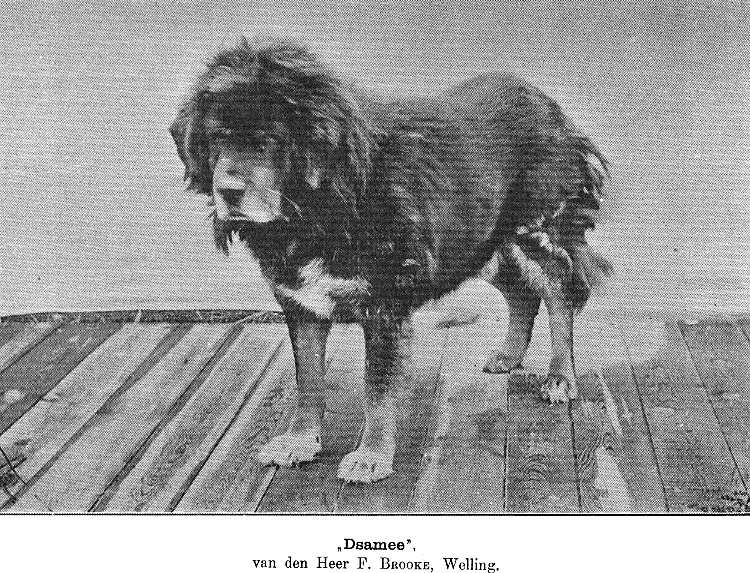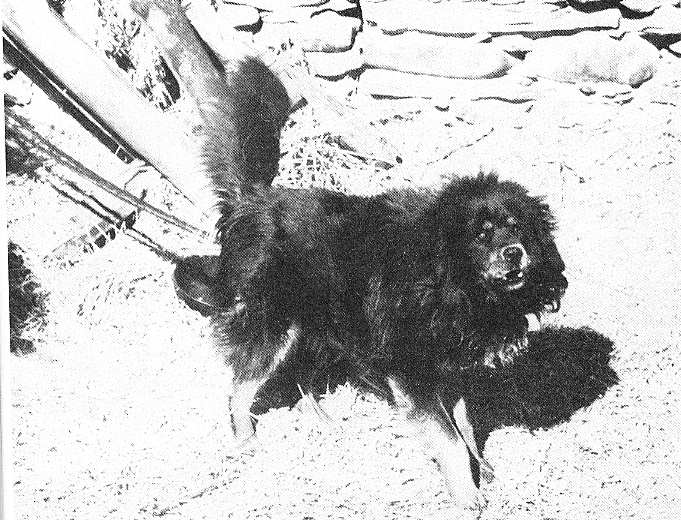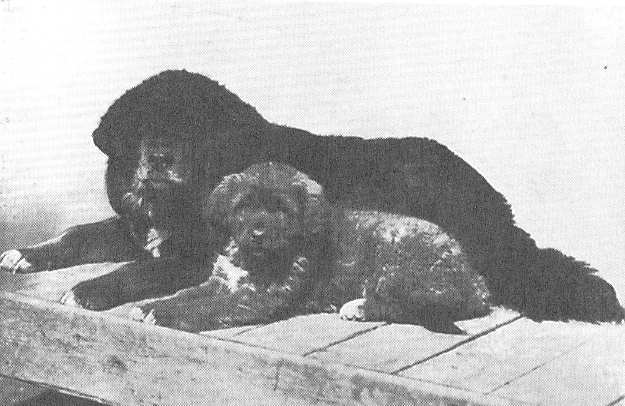|
"The true, pure, real Tibetan mastiff “
|
|
The discussions about this maintain, in Tibet purely bred Do Khyi probably is as old as the first, "modern “knowledge about these dogs, as through first travelling salespersons new stories, portrayals and descriptions in the 18. Century until beginning of the 19. Century penetrated to Europe. As the first imported dogs arrived from Tibet in Europe and could be viewed by interested kynological people as living object the realistic contemplations were sooner already at that time surprises. The guards portrayed as big, gigantic dogs of the Tibetan aristocracy houses and nomads were sober in the comparison to the portrayals small, in the type rather similar than the early Newfoundland dog, as which of the English mastiff. Nevertheless the discussions and theses about the purely bred Do Khyi from Tibet as forebear of all molossid races of the western world, the right pure type didn't rip off until into the present-days. These points of view over the pure type of the Do Khyi were allowed to the race in the breeding probably rather than harmed used. So, the narrow genetic pool of the race in Europe and America even further was reduced by insurmountable contrasts on this way. This however also in the thirties beginning of the 19. Century, an exchange between the specimen of the continent and England didn't take place. So remains only in default of directly from Tibet imported Do Khyi on the base of the politically delimited situation at the beginning of the pure breeding, end of the seventies only a view on it by 1900 still to Europe of imported dogs, which got often directly from Tibet to Europe by means of representatives of commercial companies. Failing of further knowledge until of the present-day time are the first photo receptions of these dogs still the way to be made a picture for itself about these dogs from the Tibetan highlands. To what extent one kynological the first, often from the memory by the order of drawn paintings as guidelines about the true look of the dogs of this alleged with the nomads purely bred Do Khyi can take also remained rather questionable until into the present-day time. |
|
|
Heliogravure, Max Siber " the Tibet dog" in the writing mentioned "caricature" manufactured from Richard Strebel by 1897, on the basis of ideas after travel from portrayals |
|
The most important receipt of it is located in Richard Strebels work "The German dogs “from 1904. Here, Richard Strebel feels indebted a drawing of the Tibetans Mastiff, which he had prepared together with Max Siber, after the first sightseeings to more, living original imported Do Khyi right. "As Siber told me, that he think about to write a study over the Tibetan mastiff, we argued over it for weeks, I made my hand available for him, after his dictation, the caricature was created that this writing adorns or really disfigured. Like often, I regretted it, to have verb-smelled this drawing, because it has produced a whole flock of errors and generates wishes, that I don't put right until today and could not grant. “ "It is a fact, that we artists very frequently don't take sufficiently seriously, that created forms, that originated from merely our imagination, of our fellow men are taken by us seriously and are raised on the sign. “ "As I created the head of Saint Bernard as vignette for the Munich Saint Bernard club many years ago, it was my endeavour to make the Points especially clearly visible, so I exaggerated these. However, I don't have dream it for myself leaves, that it would be for our breeding of so big influence, that the pug dog-good muzzle could be created from it. As I saw the consequences happening and raised the voice against the picture created by me itselfe, I was laughed at and was derided. It went similarly for me with the Tibetan Mastiff picture, how much inquiry after such dogs shrank with me, this would have been the lowest evil, but that serious scholars took this from picture as model, has me profoundly sadly. Today, I want to try something to rescue to rescue is, I give Tibetan mastiff in similar surroundings in Heliogravüre's (drawing) copy of the Tibetans Mastiff once again, but just like it the facts corresponds. “ |
|
|
Heliogravure, Richard Strebel Tibetans mastiff, correction of " The German dogs" first edition 1904 an realistic representation of the Tibetan Mastiff.
|
|
One can see from this correction that the most drawn pictures of the Do Khyi from early times, probably from the late ideas of travel portrayals emerged and to the contemplation about the true look of these dogs however rather the first photo documents is useful, nevertheless also until into our present-day time unfortunately still the first Heliogravuren (drawings) gladly to the imagery of the race picture is used. In the volumes of the kynologic scholar Mr. Beckmann, the two Tibetan Mastiffs, Dschandu and Dsama, becomes portray as drawing which count Bela Szecheny have bring from his trips in China and Tibet. The later photo receptions of these dogs, produced in Vienna, this painting compares clearly shows the overemphasis of characteristics, just like it already Mr. Strebel of the posterity in writing left. |
|
|
"Dschandu and Dsama" two of the Chinese-Tibetan trips from count Bela Szecheny brought Do Khyi. Drawing “ Races of the dog" of Beckmann, 1895...... one heeds the" oversubscription" of the catch part, as well as forehead height and the ear base, in the comparison to the photo reception. The standing Dschandu works more highly put and penetrated less. The bitch of Dsama gets the mastiff-good catch part... |
|
|
|
| "Dschandu" in the comparison to the drawing as photo reception photo: Rosa Jenik, Vienna - its pure type was not undisputed, some indicate an influence through the Chinese Chow-Chow (Tschau). | "Dsama" in the comparison to the drawing as photo reception photo: Rosa Jenik, Vienna the name Dschandu and Dsama comes from the Chinese and reminds on the Tan-colour of the eye markings. |
| Also Beckmann held as disappointed in writing solidly he had been about the low size of the dogs of the count Bela Szecheny. Differently than the interest of the kynologic scholars into the Tibetan dogs was bigger than with many other breeds and so exact measures of living specimen of this time are traditional for us. No one this at that time from Mr. Strebel of presumptuous Do Khyi, an instep measurement reached over 65 cm and so portrayals, which reach us again from China today, over Tibetan Mastiffs allowed to become seen them with instep heights over 100 cm appears probably merely than a profitable wish thought than the facts in accordance with. Also still today, some interested is over the "smallness “ of the Do Khyi in the comparison to other breeds more surprised. Absolutely possibly it appears that the size suffers from the ancestor loss in the western breeding. The one or other outcross breeding as well from it gives resultant size profit occasion to suspect this. Nevertheless, dimensions are to be questioned over 100 cm sooner, as well as, to ask the question, whether we would like to hold such gigantic dogs at all. The realistically viewed origin of the race in their homeland, as it was to be found by 1880 to 1930, doesn't correspond this surely. Is conspicuous on the exact surveying data of the four of Mr. Strebel of presumptuous Do Khyi that the three bitches the male dog something in strength and size, as well as head scope virtually comes on nothing takes second place, yes one of it the male dog at strength in the relationship even still surpasses. |
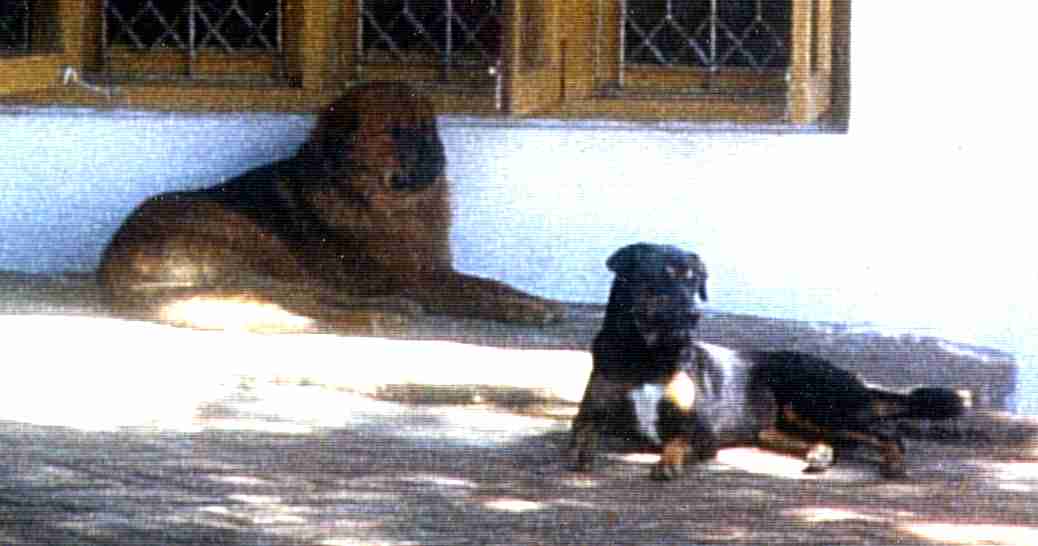 |
|
| Do Khyi with Paria-mix, reception monastery in Nepal 1990 photo: Fam. Bock | Do Khyi, in the same monastery, Nepal 1990,( narrow type) photo: Fam.Bock |
|
Newer contemplations about the development of the breeds of Professor Ray Coppinger with reference at observations from the Transhumanz, the part-nomadic way of life of stockmen, world-wide with their dogs yields another, newer picture of the formation and development of this these people of accompanied dog-“breeds”. So, the picture condenses that decisively the appearance of the height, and strength this, in the development the environment, and life conditions of the dogs, with shaped. A big dog has one to the size altogether seen have small body surface and consequently a relatively low heat loss and energy consumption which in the comparison to a smaller dog a big body surface and consequently a higher heat loss and energy consumption. One looks at the country Tibet geographically so, the most different altitudes, weather situations and environmental conditions are to be determined. The higher lain the development surroundings of the Do Khyi, the more cold and inhospitable the survival conditions the bigger should be developed the dogs there. Turned back, the more deeply and more warmly the life surroundings, the Do Khyi were supposed to have developed smaller, however, a high physical effort is connected with hyperventilation, overheating and from it resultant death with dogs in the warm climate always. A big, massive Do Khyi from high valleys, at the partial trains of the nomads, arrived therefore been not supposed to have survived long as working protection dog in warm, subtropical valleys. Portrayals of early travellers about the degenerating and early death of the Do Khyi in low, warm situations therefore absolutely find an entitlement here. Discussions about this, from which of Transhumanz (part-nomadic way of life)of the Tibetan cattlemen accrued "different type “the Do Khyi from the original regions as pure or impurely only on the basis of the height and strength, should get a new attach importance with such newer theories about the formation of breeds. Nevertheless, it is to be clearly not delimited until today in what way still the arrived dogs are rather purely bred, who justified the beginning of the race pure breeding of the Do Khyi in America like Europe, end of the seventies from Nepal, Bhutan or India or but had crossed with others already to Nepal, India however also Tibet imported western dogs. Also still today, it is fashion in Nepal or India more to own a Rottweiler, Dobermann or German Shepherd, because a Do Khyi. Also the pariah dog is in wide parts of the lower regions of Himalaya to find, even if still often mixed with western dogs. The mixture with western races, which are subject to differently than the Asian dogs the genetic influence of the North wolf, however, to regard as problematic in every case, is. The first pioneers of western breeding, by 1976 therefore could with the selection of the animals only after the appearance, the typical movement and that natures proceed, in what way one has become leave lead quite unsolved from ideals remains.
|
|
|
Jumla`s Kalu of Jumla * 1967 in Nepal 1976 imports tor South California, USA" Kalu" with St.Mary´s Kipu's of Langtang was" progenitor" of Langtang line of Ann Rohrer in the USA. |
|
|
|
| Mary´s Yullha o.Langtang, import Nepal, to rather assign the “spitz-type foreface" mentioned by Strebel in the type. | "Kalu" with St.Mary´s Kipu's of Langtang, progenitors in the Yidam-Zwinger in connection with Tü Bo of the" A"-Litter of many present-day, European Do Khyi |
| Altogether Richard Strebel 1904 distinguished two different types with the Do Khyi which nevertheless he explain kynological and could classify on the basis of his observations from the beginnings of the pure breeding with western breeds. |
|
|
|
| Form 12, Strebel photo reception Do Khyi bitch Berlin Zoo 1897 | Form 13a, Strebel photo reception Do Khyi male dog Berlin Zoo 1897 |
| “If we now cast a glance at the living dog, so it quite clearly shows us two different types, that I compares in the picture 12, 13 and 14 each other. With 12 and 13, we clearly see the spitz-type head during 14 shows the pointed head the beautiful quadrilateral mastiff muzzle. However, we can see such fluctuations just as well with our Great Danes. As they were created is not without further so to be said; it can be the endeavour to come back to the prototype on the one hand, it can have happened just as well, however, through crossed out on the other hand. So, the suspicion is specifically with the Tibet mastiffs, which occur at the foot of the Himalaya, very draws near, that pariah blood is supplied. “ |
|
|
|
| Form 13b, Strebel photo reception Do Khyi male dog, Berlin Zoo 1897 in the profile as comparison to picture 14 | Form 14, Strebel photo reception" Dsamu", owners Mr.Brooke, Welling England about 1895 instep amounts: 61 cm substances: 45 kg |
|
This remark of Mr. Strebel becomes put underneath in Ray Coppingers theories that itself as first use dogs of the human being, with selection on performances, that are supposed to have developed sheepdog of the partial nomads from pariah dogs on the Transhumanz (part-nomadic way of life) and absolutely are subject to the influence of crossed out at the hikes through pariah dogs also still today. The genetic difference this itself from it yields an insignificant one is, as one from the examinations at the Mitochondrian-DNA to the investigation of the origin of all house dogs can see. The discussions resultant from it about a pure one and a worse type this already from outset to the elimination of valuable genetic potential in the race led, the possibilities to be based the Do Khyi on a wider genetic basic stick were supposed to have restricted strongly in the western breeding. How strongly the original genetic potential also from "worse types “is, one can understand well that one casts a glance at the "exit material “, the progenitors of the Chattang-bloodline of Mr. Ravensburg. Here, four different imports from Northern India and other Himalaya justified - regions the breeding of the line, which without it, as so often usual incest breeding relationships in the only three generations were built.
|
|
|
"Shebana" the mother of the Chattang line stood in very low height Shebana x Sindhoo = Chico, bitch, black
|
|
|
|
| Motoo Mahasaya of Henley, import India, | "Motoo" and" Chico" the parents the" A" and" B"-litter van Chattang, Holland, |
| Already in the third generation are without inbreeding absolutely typical the western breed-picture to admire corresponding representatives of the Do Khyi can be found, which can be found in many genealogical trees today and led about a typical one at that time an important step further, the standard ideas of corresponding Do Khyi, to get. Also still today, this blood line stands for height in the breeding with an absolutely breed-typical appearance. |
| With the from Nepal to Germany of imported male Tü Bo, that represent a very good specimen of the race in his entire appearance, became another, important step to the front done. His descendants from a connection with one sooner to the "worse type “tending mother bitch, Yidam Aksu, Amban and before all Yidam Akbar has the race decisively, through massive breeding use shaped. Led the nowadays quite high inbreeding degree of most race representatives, with which has resultant ancestor loss from it, seemingly to a standardization of the appearance. Nevertheless one with outcross breeding to the welfare of the race health, on the other hand also still today the different types can observe. Only, that the public is shown so frankly no more this variety at dog shows today. Still beginning of the 80th of 19.th century, it was to be assessed the different types for some breeding judges heavily uniformly. |
|
|
|
| "Tü Bo", 1979 Yidam Zwinger near Fam. Boese in Germany | "Tü Bo", import Nepal was regarded as first, very good specimen of the race, instep height: 68 cm over his son Yidam Akbar very frequently was put in it, specifically in Holland. He is located in virtually each genealogical tree of European Do Khyi today, often up to 10 or 11 times over the complete generations. |
| The same experiences are for us until today, which were nevertheless created narrow incest breeding connections in the Zoo of Whipsnade gets from the records and photographies over descendants from the first breeding in England with original Tibet imports from 1928 to 1936. Also here, the high genetic potential of the imported Do Khyi absolutely is to be observed like a swift improvement of the type and the prominent shaping of race-typical characteristics with beginning of a pure breeding. |
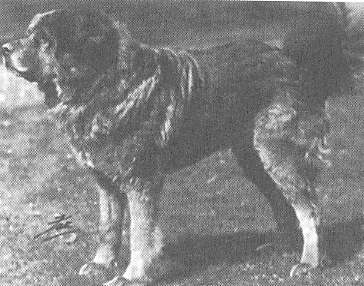 |
|
|
| "Drenjong Dakpa" import Tibet owner.: Mrs.Bailey, England 1934, | "Gyandru", import Tibet owner.,: Mrs.Bailey, | "Tonya" *1933 in England near Mrs.Bailey owner.: Mr. Bates |
|
England 1930, |
|
|
|
| "Gyamdruk" import Tibet/Ladakh owner.: Colonel Mr. Duncan, England 1936 | "Gyamdruk" is not from the" pure" type like this head reception surely shows, he unequivocally almost shows no one stop Gyamdruk had a litter with Tonya above, Bru" comes" from it |
|
|
The" improvement" of the breed type, to see, here in the" Whipsnade-kennel", England 1932 until 1940 from original Tibet imports. The race characteristics, bone strength, clearly are width, pleat formation, eye form and expression to be recognized. "Tonya", the light bitch, * 5.2.1933 (Rakpa x Gyandru), here in the age of approximately, 6 years together with her son" Bru" * 28.12.1936 (Tonya x Gyamdruk) of the mother-son mating ( Tonya x Bru) was still yielded several litters. The track of the dogs vanishes with the Second World War.
|
| One should not let oneself meanwhile led from ideals, however, the re-achievement of the typical breed picture was important in the breeding of the first pioneers, as well as the receipt of the primary, deep mastiff from Tibet. |
|
|
|
| a typical bitch, Tibet import, England by 1930 | "Dsamee" Tibet import, male dog England about 1895 owner.,: Mr. Brooke Welling, England this male dog shows the typical mastiff muzzle, bone strength as well as mane formation, which let the head work more powerfully, |
|
|
Do Khyi in its homeland Tibet by 1945 with one of the original utilities as," caravan dog"
Photo: Prof. Heinrich Harrer, 1945,
|
|
Notably, the unambiguous, until middle-long completely hair, which doesn't form any long flags at the low extremities, is a moderate one at all early receptions of Do Khyi from Tibet or the low regions in Nepal, Sikkim or North India and overemphasized not stop, head and catch length are virtually same and lie parallel in the profile in the most favorable case. The head even forms an approximately straight line and no crawl-good curve between the ears. The body always stands in the relationship by the head, a mane with crown formation especially strongly distinctive with the male dog can let the dog appear essentially more strongly than it here is. In the summer however, the Do Khyi appears also according to portrayals from the early times in the simple summer dress always. However, the twill relationship always is conspicuous from height to the length, as well as the easy, effortless and springy walk own only the Do Khyi. As race-typical, also the late, physical maturing partly must until in the 6.th age of life is looked at. It is to watch these points still important surely, also the Eastern Asia researcher |
|
Matthias Herrmanns points to, which itself to the exploration of the circumstances and the cattle-raising of the Amdo - nomads from 1935 to 1945 in Tibet, on several, detained different dog breeds with the Amdo-Nomads with different use purposes. "In other areas of Tibet, more breeds occur. The different races then are many times crossed out “.
|
|
|
"Shekar Gyandru" (mother of Tonya 1933), England 1931 with a puppy from the first litter, portrait of Head also sees above, owners. Mrs. Bailey picture: Hutchingson´s Dog Encyclopedia
|
|
The pure Tibetan
Mastiff something a rare breed therefore with the Tibetans, nevertheless its
genetic potential probably for lacquer of" pure breeding “in much dog hits
of the Himalayan Region would be to find. It wants be the big danger
therefore with the Do Khyi breeding in the westerns, a type which in
accordance with" Showy “is, to give the preference. However, the big Tibetan guard of the nomads of the highland then is no probably more this. |
| Ruth Reheuser 11/2002 |
|
|
![]()
